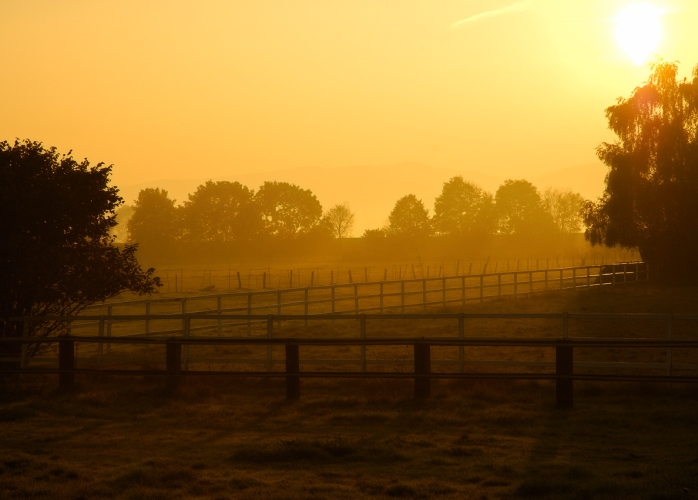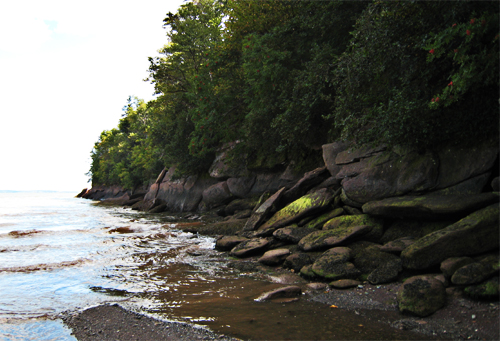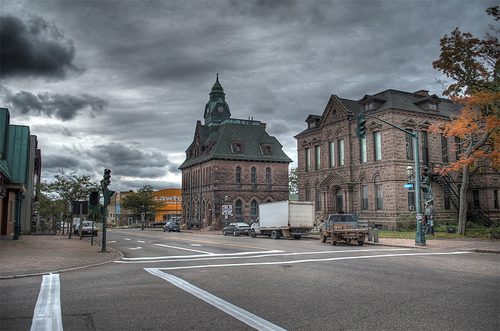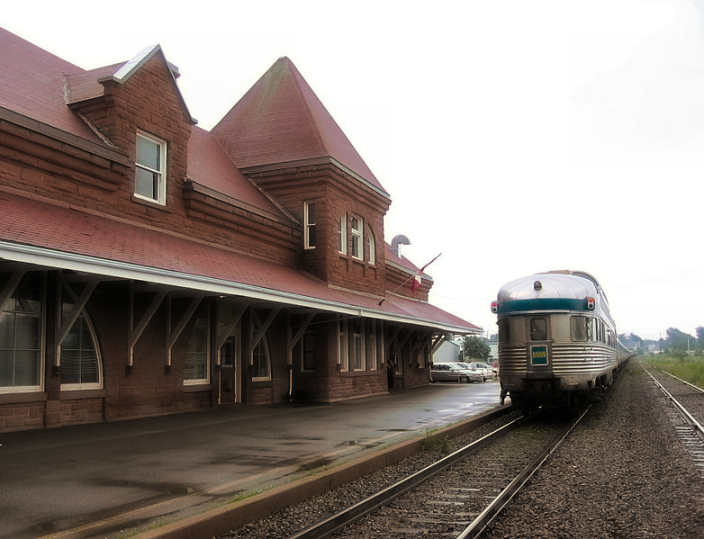Territory

GRAND LAKE
The northwestern area of the territory will become the production sections of Vinátta. Laying claim to a long stretch of the shore gives them a strong supply of water and it is for this reason that all of these structures sit clustered nearest to the lake. Perhaps luckily for Vinátta, farms were a common occurrence before the fall of humanity and while there are repairs that need to be done on most buildings, the structures themselves are strong, well built structures.
Stables & Paddocks
Situated about three miles from the Grand Lake, southeast, sits a quaint livery yard, named as ‘Marsh Valley Livery’ on a small, broken sign by its entrance. While the front gate has long since been removed, the majority of the fences serving as the perimeter remain and it is advised to find a gap in the fences than try to climb over them. Within the compound, a few distinct structures can be seen. First and foremost is the stable block- two stout brick buildings facing each other over a path of concrete that has mostly survived the ravages of time. Of course, the wooden doors on the stables have not quite survived and most are in need of repair or replacement. However, with space for 40 horses, the stables are an investment for Vinátta. Alongside the stable block are the remains of 10 paddocks, whose fences are likewise in need of repair. Behind the stables is the skeleton of a large hay barn, which has the potential to become functioning once more. For a list of animals living at the stables, please see our Stables Page
Grazing & Crop Fields
Approximately six miles from the Stables is a small farm settlement that serves Vinátta as housing and grazing for livestock they may gain as well as providing fields for growing crops. While no boundary surrounds the entire area, there are boundaries around large sections of grazing with a small barn in two of the fields for housing. As with the paddocks in the stables, the fences will need repairing and small sections of the barn should be replaced but the stone of the barn has stood well against the weather and only minor repairs will need to be undertaken.
Raudr Vineyard
Previously a successful vineyard near the banks of the Grand Lake, the Vineyard was renamed as Raudr Vineyard when Vinátta moved in. Spread over 100 acres of land, the Vineyard boasts an impressive variety of L'Acadie (white) and Lucie Kulhmann (red) grapes in large orchards. Founded in the early 1980s, the brewery's brick foundation is still functional, dotted with a vast underground cellar. Once the grape vines are free from the weeds and trimmed down to something more manageable, the grapes will be harvested in early autumn and made into wine for Vináttan consumption as well as trade.
Sacred Grove
The Sacred Grove was cultivated by Miskunn Stormbringer when Vinátta moved in to the area. A small grove in the expanse of forest, the Grove serves a religious purpose. Standing dominant in the centre of the Grove, a giant White Walnut tree rests. It is said by the Godja that this tree is representative of Yggdrasil, the life tree, and is worshiped fervently by those who believe in the Old Norse way. All Frithr Necklaces are carved from the branches of this tree. The Godja is usually found in this little grove, worshiping the Gods. Miskunn Stormbringer made a small alteration to the grove when it was first discovered- the addition of Horgr stones in between the roots of the Walnut tree. These Horgr stones are perhaps the Norse equivalent of altars and they appear in stacks of stones in all shapes and colours. Members may seek the Godja out for advice here.
Idun's Meadow
Situated near the Sacred Grove, this break in the dark forest is filled with light. In the spring when the snow has melted and the flowers start to bloom, the heavy scent of their perfume fills the air along with the buzzing insects and graceful butterflies that aid in their pollination. The grass grows high enough to obscure a full grown lupus. The meadow gets its name from the single apple tree that grows near the middle of the field; the old tree seeming to have been there forever. The bark is dark and cracked with age, yet the tree still blooms every year, adding the sweet fragrance of apple blossoms in spring, and providing golden yellow apples in the summer months almost as if they are a gift from Idun herself. (Created by Djiacamo)
COMMUNE OF THE SALMON
To the south of the Grand Lake is the area known as the Commune of the Salmon, to which Vinátta currently lays claim to. As with the majority of the Vinátta’s territory, the Commune of the Salmon is shrouded in forest. The ground in this area of the territory becomes bumpier, hills a common occurrence.
Jordheim
Perhaps the most memorable aspect of Vinátta’s territory, Jordheim is the residential area for the pack. In times of humanity, a group of eco-warriors retreated to the woods and built a community of earth houses into the hills and valley. The houses themselves are built with little organisation and sit hickledy-pickledy in the valley that creates the majority of Jordheim. The houses are actually stone and brick underneath- perhaps not the most environmentally friendly but necessary to support the substrate covering them. The earthen houses themselves blend well into the scenery due to the large amount of earth and grass that mold them into the hill and valley. With a small porch area (showing the building materials beneath the earth), the beautiful wooden doors and thick glass windows, it is not difficult to understand how these structures have withstood all nature can throw at them. For a detailed lists of claimed houses, as well as a map of Jordheim, please see our Jordheim Page
Communal Garden
West of Jordheim lies the communal herb garden, created by Saul Stormbringer and Colibri Haki in their first month of residence. Herbs and wildflowers with medicinal properties are gathered and grown here for the good of the pack. Witch-hazel, Meadowsweet, Common Sage, Catnip, and Chamomile are just a few of the many plants here, which are free for all members to use and care for. There is also a raspberry bush and several apple saplings flourishing in the back, cultivated by Colibri.
Sveit Village Hall
East of Jordheim is the freshly-constructed Village Hall, built in the summer of 2012 by a dedicated group of Vináttans with the help of a Cercatori member who was indebted to assist on the construction. Notably, this building houses a detailed map of the territory, as well as the pack Almanac. Visually, the Almanac is easily distinguishable and is in the form of a large, leather-bound book placed on a lectern in the front corner of the Village Hall. The pages are dusty but not overly fragile at the moment. Entries at the front of the book are the oldest, and record the pack's history for all literate members to read.
Evergreen Tangles & Kissing Trees
A mixed wood of evergreen trees and bramble creates a literal maze of paths and nooks through otherwise thick, impassable forest. These paths lead both further into and away from the territory and entrances are harder to find during the warmer seasons, when plants grow thick around them. Ferns, fiddleheads and vines grow freely along the paths' edges, making for an exotic appearance. Deep in the center of all of these paths, a more cultivated tunnel has been named the Kissing Trees. At one point two separate columns of trees have bowed together, branches entangled like lovers. In the autumn, berries adorn the Kissing Trees. At the end of the tunnel, a small clearing gives a secluded spot to those who can find their way here. (Created by Sky & Rat)
Futhark Falls & Lovers Leap
Hidden among the overgrown hiking trails of the Fundy National Park is a collection of small waterfalls known as Futhark Falls. The fresh water falls into shallow drinking pools, trickling over mossy rocks along the slope or splashing down in larger cascades, and tastes of the mountains. Vegetation grows thick here, and other than a few broad streams branching away or feeding into the falls, there is little danger of raging rapids forming. Ironically, the construction that served to keep the human safe on this scenic trail is the most dangerous part of visiting the falls; most of the wooden stairs and paths are sturdy, but some have rotted through and might send an unsuspecting Luperci careening down a steep slope. Just a small way down this steep slope, the ground levels out and shows one particularly old and gnarled oak that has borne the brunt of time and is scarred from the carvings of human couples, some dating back further than a century. The base of the bole is hollowed and provides a shady escape, just large enough for two Luperci, the inside of this hollow also bears the crude markings of long deceased humans expressing their love for one another. A sturdy rope has been tied over one of the old limbs, hanging out over the shallow, clear water with a petrified branch serving as a seat of sorts to make a swing. The rope is long enough to swing over the brook, but short enough to be sat on and foot paws dabbled in the cool water of the brook. (Created by Raze & Djiacamo)
Hart Pond
Near the most North Western part of the territory, hidden behind Jordheim and the thick woodland, is a small and colourful clearing, dotted with wildflowers and all but hidden by towering trees. Often the sunlight can't reach through the canopy here, but there is a space which allows some light in from above, and this light is sometimes cast on the Hart's Pond. The pond is a few feet in diameter, bordered by grass and rushes, and populated with amphibians and many aquatic plants, some of which may be useful in herbalism. There may even be the odd gem hiding among the colourful pebbles which are often visible, due to the water's clarity. The pond is frequented by many smaller animals seeking water, if they can get through the trees, but also by deer. Occasionally a stag might be spotted – hence the pond's name – but the more obvious signs are parts of antlers which have been broken or shed, which can be found buried among the thick bushes on the edge of the clearing. (Created by Rat)
COASTLINE
The southernmost terrain that Vinátta lays claim to is part of the Wabanaki coastline, stretching along the length of the territory. A natural harbour further up the coast gives this stretch of ocean and sand a calmer aspect than most. Fishing and swimming are feasible activities in the calmer waters, while the beach consists of soft sand and pebbles.
Rán's Watch
An old lighthouse weathered by the passage of time. Named after the Norse goddess Rán, it stands tall above the rolling waves as a beacon of safety to passing sailors. The paint is all but worn off, and the windows cracked and busted. In the winter, the entire building becomes coated in a thick layer of ice from the spray of the sea. But the structure itself is remarkably sound. A fair bit of sea water is thrown in, which gives the building a damp smell and a slick floor. There are a couple of empty rooms which have remained mostly dry, but others have rotting floorboards and patches of damp on walls and ceilings. The items inside are unremarkable at best; a few coils of frayed rope, a couple rusted tools, and other miscellany. The highest level, the room in which the light used to burn, is more dangerous still but if one was brave enough to climb the creaking spiral stair to the top, they might discover the intelligent, old osprey that makes his home here. The view of the ocean, even with the danger of the rickety rail make the climb definitely worthwhile however. (Created by Leah & Rat)
Hoggva Strand
Also known as the Hopewell Cape. The high tides of the Bay are especially prominent on the Hoggva Strand, where large rocks up to seventy feet high have been carved from the ebb and flow of the tides. At low tide, this area is a fun place to explore: check out the odd topheavy shapes and arches of the rocks, or chase nesting shorebirds on the cliffs! However, Vináttans are advised to avoid the high tides, which completely cover the beach twice a day. An unsuspecting canine might very well get washed away or trapped in the caves and other sandstone formations carved by the water. The area is also a popular destination for a variety of shorebirds, which tend to nest and feed in the area. The most common shorebird species are sandpipers, dowitches, plovers, knots, sanderlings, and dunlins. Peregrine falcons, merlins, osprey, cormorants, eider ducks, and the great blue heron are also common to the area. Horned and barred owls have also occasionally been spotted. (Created by Raze & Tammi)
Sing Sands Dunes
At the edge of Vinatta’s coastline are the singing sand dunes. Steep semi-fixed dunes with a great view of the whole coastline and, in the other direction, of the interior of Vinatta. Discovered by founding member Bran Stormbringer, he is convinced these should be called the Bran Dunes, and knows that taking a piece of driftwood, standing on it, and skimming down them, is just about as much fun as you can have while keeping a clear head. Other than, looking really cool, the dunes have another surprise, they sing. The ridges made by the sand make an eerie noise when the wind is blowing in the right direction and passes over them. The noise is incredibly haunting, doubtless leading some to believe that spirits, benevolent or otherwise, reside there. Despite patrolling the area many times, Bran’s seen no sign of this, but it’s a strange place sometimes. (Created by Draiko)
AMHERST
Vinátta expanded their territory north to claim a section of Amherst, to include various stores and a children's playground and park. Amherst was a large and sprawling town in the time of humanity. Its remnants are a queer mix of early construction -- sprawling Victorian homes and stone churches -- and evidence of rising commercialism -- warehouses and big chain stores. One thing both new warehouse and old Victorian share are the signs of natural reclamation -- even in this once-bustling town, signs of human occupation are decaying quickly. Saplings and shrubs sprout from cracks in the asphalt, and the sidewalks slowly lose their battle with the roots of elder trees.
Rainbow Towers
The castle is made up of two towers, with bars of rusted metal keeping them up and funny, random shaped sides covering them. Each tower has an accompanying slide, which had remained strong over the years, although enough weight put on it will cause a collapse. Random metallic bars sprout from the sides of each tower, and all bent in different ways to allow entry into the castles. One of the towers is connected to smaller ones by a spiderweb of rope, which had turned green over time of damp decay. Colorful markings of graffiti coat any flat surface of the play park. The castles once lay on cool, green grass, which has dried and turned to dust over the years of neglect. A small sand-pit lies between the castles, which inspires some pups of Vinatta to believe that treasure is buried there. Although they would be lucky to find any real treasure, old glass bottles could be found folded in the sand. There is a clear difference between the two towers, both in color and size. The tower connected by tangled ropes has a theme of deep blue, which has faded to a lighter blue over time. The larger tower is covered by pyramid shaped roofs, protecting its inside by minor drops of rain. The smaller tower is more varied in its colors, but if given a theme of color, it would be yellow. The bright, sun yellow has faded into a cream over the years, and unlike the larger tower, it doesn't have a roof, and is therefore exposed to attacks from the weather. (Created by Jazzy)
Stálormr Path
The Amherst Railway Station is an otherwise nondescript red building, with strange steel tracks spanning through the town and out into the wilderness of New Brunswick and even possibly the rest of Nova Scotia. No one knows how far this trail goes, but the section of it in Vinátta has been dubbed the Stálormr Path and marks a natural trail through the territory where trees were cleared down by humans. The route is a very scenic one, though occasionally the rusted skeletons of old railway cars dot the tracks -- a good place to hide out a storm. Many of the fields created by the railroad are full of deer, rabbits, and other animals that prefer a more open area to feed or burrow. (Created by Raze)
Hallet's Cove
This old harbor town was once a quiet little turnout on the outskirts of Amherst. The few boats lining the banks are half sunk into the muck, or otherwise submerged in the still waters of the inlet and are completely unusable. Many of the docks that just out into the water are missing boards or suffering from extreme decay due to the damp, and quite dangerous to walk on. However, there are a few gems to be found in the old fishery shops; hooks, rods, and even old gear have been stored away out of the weather, and remain in relatively good condition! (Created by Leah)



















